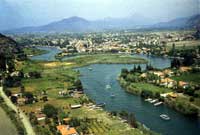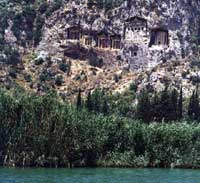Dalyan/Caunos
 Situated
on the border of ancient Lycia and Caria, Caunos receives much attention today
for the fact that it is very close to where the giant loggerhead turtle Caretta
Caretta goes ashore to deposit its eggs, for its Lyciantype tombs, for its
Venetian-like channel and most importantly for its ruins. For those who arrive
by yacht, you will sail from Ekincik Limani to Delikli Ada, where you can anchor
and rent a small taxi boat to reach the ruins.
Situated
on the border of ancient Lycia and Caria, Caunos receives much attention today
for the fact that it is very close to where the giant loggerhead turtle Caretta
Caretta goes ashore to deposit its eggs, for its Lyciantype tombs, for its
Venetian-like channel and most importantly for its ruins. For those who arrive
by yacht, you will sail from Ekincik Limani to Delikli Ada, where you can anchor
and rent a small taxi boat to reach the ruins.
The existence of the Caunos ruins, which are interesting from every aspect,
was made known in the year 1842. Two digs were conducted, one in 1877 and the
second in 1920. Current excavation work has been carried out by Turkish
archaeologists under the direction of Prof.Baki Ogün since 1967.
Ancient geographer and historian Strabon, who was from the town of Amasya in
Central Anatolia, informs us that he saw a shipyard and a harbor in Caunos. The
harbor that he referred to has been replaced by the lake of Sülüklü, which is
situated below the acropolis. In ancient times, the sea used to come up to the
back of Caunos, nearly surrounding the entire acropolis.
The geographer Scylas, who lived in the 4th century B.C., emphasized the fact
that Caunos was a Carian city and stated that the Lycian border began a little
further on, E of the Dalaman Stream. The city was named after its founder,
Caunos, who was the son of Miletos. The famous historian Heredotus wrote that
the inhabitants of Caunos believed that they were natives of the region and that
their language resembled that spoken by the Carians. The inscriptions uncovered
here in recent excavations resemble those of other Carian cities, which confirms
what Heredotus had explained centuries ago.
 Caunos
revolted along with other Ionian cities against the Persians, who had captured
all of Anatolia in 546 B.C. However, as the revolt failed, Caunos, along with
all the other coastal cities were once again subject to Persian rule. As
Mausolos, who was the Carian satrap of the Persians, wanted to implement
Hellenic policies in the region, whereby Caunos could not avoid becoming
affected by this situation, in that the fortification walls around this city
were erected by Mausolos.
Caunos
revolted along with other Ionian cities against the Persians, who had captured
all of Anatolia in 546 B.C. However, as the revolt failed, Caunos, along with
all the other coastal cities were once again subject to Persian rule. As
Mausolos, who was the Carian satrap of the Persians, wanted to implement
Hellenic policies in the region, whereby Caunos could not avoid becoming
affected by this situation, in that the fortification walls around this city
were erected by Mausolos.
With the defeat of the Persians by Alexander in 334 B.C. Caunos, together
with all of Caria was left to Queen Ada. After Alexander’s death in 323 B.C.,
the city was captured by his general Antigonus in 313 B.C. Two years later,
Ptolemy seized control of the city from the sea, However, Antigonus regained the
region by defeating Ptolemy during the Salamis Naval Conflict in 306 B.C. Caunos
was annexed to Lysimachos in 286 B.C. and to the Kingdom of Rhodes in 189 B.C.,
where it remained until 167 B.C., when the Pergamon Kingdom took over Caunos.
Subsequently, the entire region was put under direct rule of the Romans in 133
B.C.
During the first century A.D., the harbor of Caunos began to fill with silt,
similar to what had occurred with the harbors of Ephesos and Miletos. Though it
prospered during the Roman Period, its importance waned during the Christian
Period, even though it had three churches within its borders.
As the taxi boat winds its way through the channel up to Caunos, you will
suddenly come face to face with several magnificent Lycian-type rock tombs.
There are three stone beds inside the tombs in which the deceased were placed.
From the fragments of earthenware uncovered, the tombs have been dated to the
4th century B.C. One of the three of four inscriptions that were found just
above these tombs, contains two words related to the Carian language, while it
is understood that the other tombs were recycled during the Roman Period. The
facades of the tombs, which were carved out of the sheer rock have two columns
of the Ionian order. On top of the columns, you’ll see exterior friezes above
pediments which were decorated with acroters in three corners. Most of the
columns are no longer intact. Of the pediments, all but one is plain, with a
unique example of a relief of two lions positioned face-to-face. To the side of
this incredible group of tombs is yet another tomb, which is plainer, and
incomplete. On the W end of this group of tombs, which is near the village, are
more Carian-type tombs which were not decorated like the others. In addition,
there are niches that were opened on the lower rock surface for votive offerings.
The name Dalyan’ means fishery, and a complicated system of barriers has
been built among the reeds to allow the gray mullet and sea bass to be caught as
they head for the sea. Let’s go ashore at the landing next to the fishery and
wander around the ruins. The first thing we see is the acropolis of Caunos,
which rises 152 m. high over a cliff in the S quadrant. The fortification walls
situated in the N quadrant appear to be from the Middle Ages.
The long wall starts N of the harbor then stretches in a NE direction to come
to the steep rocks located up high over the village of Dalyan. The N portion of
the wall appears to have been built during the time of Mausolos. The walls in
the NW section possess characteristics from the Hellenistic Period. The walls
from the harbor to this section were erected in the Cyclopean style and remain
from the Archiac Period (5th-6th centuries B.C.) These long walls stretch the
length of an empty, desolate field.
Lets start our trip by going straight over to the theater at the bottom of
the acropolis. The S section of this theater, which measures 76 m. across, was
carved out of the rock. Its skene, which measured 38 x 8.40 m. is demolished
while its orchestra section is filled with soil. The theater was constructed so
that its front face looked towards the W. As for the sections that were not
built into the rocks, seating rows were constructed over cradle vault supports.
There were a total of 33 seating rows divided into nine sections. As far as its
layout is concerned, it resembles a typical Greek theater, but due to the
vaulted lower structure, we assume that it was constructed during the Roman
Period.
There are three structures to the W of the theater. The first of these is a
basilica-type church, which was constructed from ashlar blocks and comprised of
an apse and three aisles. To the S of the basilica are a vast Roman bath and a
palaestra. Beyond the baths complex is a cistern, whereas there is a temple
behind this, which dates back the Roman Period. To the N of this temple is
another temple in the Ionian order which was erected in the in-antis style.
After seeing these edifices in the upper part of Roman Baths. Canons, let’s
descend next to a round structure down below. You will notice a few smooth white
marble columns spaced over regular intervals are positioned over a marble
semi-circle. Behind this edifice is an eye-catching podium in the shape of a
semi-circle that has been raised three steps. There was a temple in the Dorian
order with an in-antis plan. The relation between the round structure and the
temple has yet to be determined.
Today’s Sülüklü Göl was once a harbor that used to be sealed off with a
massive iron chain during antiquity. Excavations carried out in the N of the
harbor have revealed a stoa that looked out over the harbor. A number of statues
and pedestals were positioned at both sides and in front of this stoa, which
represented a wing of the harbor agora. This 94 m. long stoa, was one-sided and
had two stories, the bottom one of which was of the Dorian order. An inscription
found here mentions that the people of Caunos thanked the Romans for the
contributions they made in beautifying their city.
There is a fountain facing the nearby stoa, measuring 5.2 x 8.5 m., which has
bars in front of it and was erected in the in-antis plan. There are several
inscriptions found on the side of the fountain facing the harbor which date to
the 1 st century. The text of this mentions customs rules and regulations. Also,
in front of the fountain is a votive which was presented to Vespasianus.
Of the inscriptions found in the center of the city, we learn that there were
several temples in Caunos which were dedicated to various gods and goddesses.
One of these was on the shore of the harbor, E of the agora. This 2nd century
A.D. Corinthian temple, which had four columns, was constructed from
architectural fragments cannibalized from other, older structures. Once we wrap
up our tour of Caunos, let’s head back to our motorboat, which will transport
us back to the present through that Venetian-like channel.
 Situated
on the border of ancient Lycia and Caria, Caunos receives much attention today
for the fact that it is very close to where the giant loggerhead turtle Caretta
Caretta goes ashore to deposit its eggs, for its Lyciantype tombs, for its
Venetian-like channel and most importantly for its ruins. For those who arrive
by yacht, you will sail from Ekincik Limani to Delikli Ada, where you can anchor
and rent a small taxi boat to reach the ruins.
Situated
on the border of ancient Lycia and Caria, Caunos receives much attention today
for the fact that it is very close to where the giant loggerhead turtle Caretta
Caretta goes ashore to deposit its eggs, for its Lyciantype tombs, for its
Venetian-like channel and most importantly for its ruins. For those who arrive
by yacht, you will sail from Ekincik Limani to Delikli Ada, where you can anchor
and rent a small taxi boat to reach the ruins. Caunos
revolted along with other Ionian cities against the Persians, who had captured
all of Anatolia in 546 B.C. However, as the revolt failed, Caunos, along with
all the other coastal cities were once again subject to Persian rule. As
Mausolos, who was the Carian satrap of the Persians, wanted to implement
Hellenic policies in the region, whereby Caunos could not avoid becoming
affected by this situation, in that the fortification walls around this city
were erected by Mausolos.
Caunos
revolted along with other Ionian cities against the Persians, who had captured
all of Anatolia in 546 B.C. However, as the revolt failed, Caunos, along with
all the other coastal cities were once again subject to Persian rule. As
Mausolos, who was the Carian satrap of the Persians, wanted to implement
Hellenic policies in the region, whereby Caunos could not avoid becoming
affected by this situation, in that the fortification walls around this city
were erected by Mausolos.